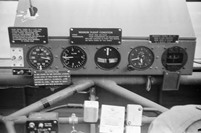XCG-15
XCG-15A
CG-15A
Some pilots at Wright Field in late 1942 and early 1943 lived at the Biltmore Hotel in Dayton, Ohio. The Biltmore was a hangout for AAF pilots and there was a lot of conversation about flying. Chet Decker, Floyd Sweet, Lee Jett and Bob Cardenas lived there for a time. Chet Decker and Felix A. Chardon shared a room at the Biltmore when Felix went to work for WACO in Troy, Ohio. Conversation in the evening centered on flights that day. One evening at the Biltmore a discussion between Chet Decker and Bob Cardenas brought up the idea of a CG-4A without the outer wing panels to shorten the wings.
Floyd Sweet was brought into the conversation and it was concluded that flaps would have to be added to keep the stall speed down. In addition, combat experience had shown there was a need for a glider that could land in a small field and be towed by a fighter such as the P-38. It was thought that there would be need for a great number of gliders for the invasion of Japan and the design shortcomings of the XCG-4A could be corrected in a new model. It also was important to keep the CG-4A in production rather than modify it, so a new model was proposed. The design was a sixteen place article with a five hundred pound load carrying increase over the CG-4A, designated XCG-15. Maj. Floyd Sweet was project manager for the XCG-15 and contributed practically all of the refinements of the design.213
October 14, 1943, a change order number twenty in WACO's second five hundred article production contract AC-25851 took the seventy fourth serial number in that block of CG-4A serials and it became the XCG-15. WACO delivered the XCG-15 #43-37082 on January 10, 1944. All changes specified for the CG-4D at the November 15-16, 1943 conference for glider design specifications were to be incorporated into the CG-15. However all of them were not completed by the time the XCG-15 was delivered in January. XCG-15 flight tests began in February. Pilots for the test flights were Lt. Butler, F/O Bartlett, F/O Burlingame and F/O Patterson. These tests were so successful a recommendation was made that the CG-15 go into immediate production. A contract was issued for one static test article and two flight test articles designated XCG-15A and built according to the latest design, adding more modifications to the XCG-15. The serials 44-90987 and 44-90988 were the two XCG-15A flight test articles.214 After the two XCG-15A's were delivered, XCG-15 #43-37082 was returned to WACO and reworked to make it into a CG-15A including changing the wheel carriage from the CG-4A to the CG-15A carriage. There is a photo of this number after complete conversion at the WACO factory. There is a photo of it standing decrepit, wanting to be saved. It was destroyed.
To some extent, the glider was a redesigned CG-4A. It used the CG-4A airfoil section, with new ailerons and flaps and eliminated the hydraulic wheel carriage, mounting the axle directly onto the bottom of the platform and a more aerodynamic nose was added. The wing span was reduced to 62.2 feet from 83.67 feet. The tow speed increased to 180 mph and the designed landing speed was fifty-three miles per hour. This tow speed of 180 mph matched the cruising speed of the C-47. Crash protection was designed into the nose as well as the nose being more aerodynamic. Crash protection was also designed in for the passengers. The tow line attachment point was on the nose below the windscreen rather than on top of the nose above the windscreen. This tow point resulted in better control during towed flight. The useful load was 500 lbs. greater than the CG-4A. The landing gear was improved and pilot visibility was increased. Emergency exit doors were placed on each side of the cockpit. Other modifications allowed the glider to be classified as a sixteen place article. The XCG-15A was successfully flown October 24, 1944 at Clinton County Army Air Field.
Tests proved the XCG-15A to be superior and to the credit of Maj. Floyd Sweet, the project from conception to delivery of production articles took only fourteen months. At first, Northwestern and WACO were offered contracts for the CG-15A, but with the 1945 heightened production demand for the CG-4A, Northwestern built CG-4A’s and WACO become the only contractor building the CG-15A. Several CG-15A gliders were sent to Europe. The first complete set of parts arrived at Air Depot #2 in England (author assumes Warton was Air Depot #2) on March 27, 1945. On March 29, the first CG-15A was assembled and satisfactorily test flown in England. There were seven gliders in this first shipment. All were assigned to the 440th T.C. Squadron of the 50th T.C. Wing.215 Glider pilot Gene PreFontaine in No Where to Go But Down states he flew one of the new gliders to St. Andre France then to a base near Stuttgart Germany in late April 1945. CG-15A gliders also were shipped to the Philippines. The program called for a total delivery of 1,000 before January 1946. There were only 385 fifteen place and 42 sixteen place delivered; 427 total before Japan surrendered August 14, 1945.
213Information summarized from letters to the author and conversations with Felix Chardon, Robert Cardenas and Floyd Sweet.
214U.S. Military Aircraft Designations and Serials, Midland County Publications, UK.
215TDY (temorary duty) report by Capt.
Note: A technicality in naming the CG-15/CG-15A. The (X)CG-15 was a set aside from WACO contract for a CG-4A. This item then became the (X)CG-15--which kept the already installed CG-4A wheel system with hydraulic brakes. The cockpit assembly was what became the basic 15A assembly. The wings were shortened for the flight testing of the XCG-15 along with the cockpit. This was the only (X)CG-15. Two XCG-15A followed and all production of the 15 were CG-15A.
|










